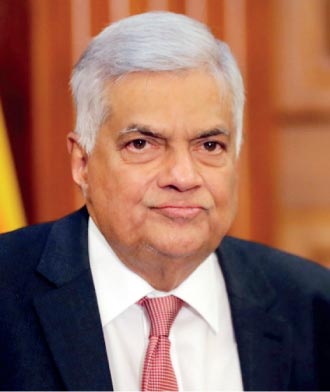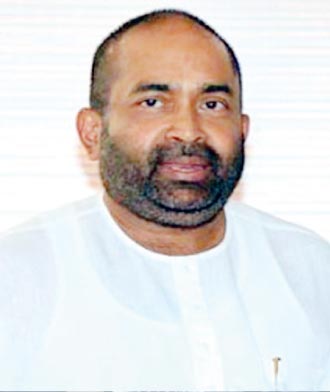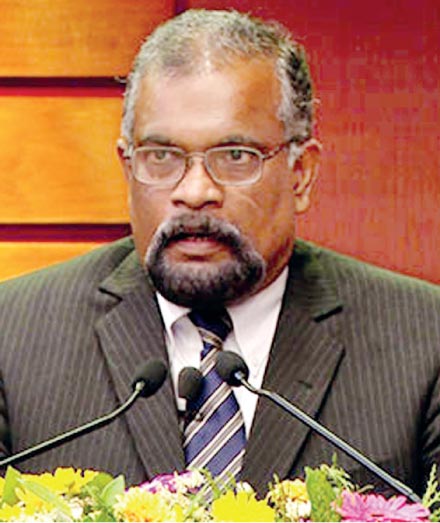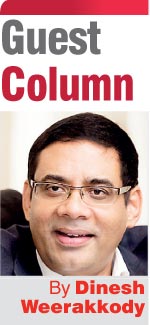Friday Jan 16, 2026
Friday Jan 16, 2026
Monday, 26 June 2023 00:30 - - {{hitsCtrl.values.hits}}

President and Finance Minister Ranil Wickremesinghe

State Minister of Finance Shehan Samarasinghe

State Minister of Finance Ranjith Siyambalapitiya

Central Bank Governor Dr. Nandalal Weerasinghe

Treasury Secretary Mahinda Siriwardena
 Sri Lanka’s domestic debt optimisation is yet to be finalised, let alone officially announced by GOSL. Premature speculation would undermine market confidence, State Finance Minister Shehan Semasinghe said recently addressing a forum. When the markets are rattled, there may well be a rush to the exits by GSec. holders and this could trigger a similar rush to the exits by FD holders towards Financial Institutions holding lower GSecs. This movement in liquidity will cause stress in the Banks and other FIs – something Sri Lanka can ill afford at present and most certainly can do without. One wonders whether this media frenzy and over reading into a special bank holiday on 30 June followed by speculating on an impending DDO announcement in the next few days, is more skulduggery than refined financial literacy.
Sri Lanka’s domestic debt optimisation is yet to be finalised, let alone officially announced by GOSL. Premature speculation would undermine market confidence, State Finance Minister Shehan Semasinghe said recently addressing a forum. When the markets are rattled, there may well be a rush to the exits by GSec. holders and this could trigger a similar rush to the exits by FD holders towards Financial Institutions holding lower GSecs. This movement in liquidity will cause stress in the Banks and other FIs – something Sri Lanka can ill afford at present and most certainly can do without. One wonders whether this media frenzy and over reading into a special bank holiday on 30 June followed by speculating on an impending DDO announcement in the next few days, is more skulduggery than refined financial literacy.
The Central Bank Governor Dr. Nandalal Weerasinghe stated in early May 2023 that public bank deposits and the stability of the banking system will be safeguarded in any reorganisation of domestic debt. The CBSL, according to sources, has opted to implement a debt re-profiling procedure for CBSL’s own T-bill holdings and outstanding local T-Bonds (around Rs. 9,032,153.4 million). Whatever the current debt structure is, it will be vital to introduce such a mechanism to meet the IMF’s net financial requirement for Sri Lanka’s debt sustainability as well as meet external private creditor conditions. Sovereign Debt Restructuring is driven by the GFN (Gross financing needs), the forward Sovereign Debt Perimeter, the forward Debt Service to GDP and other factors that dominate the IMF’s DSA (Debt sustainability assessment) which in turn is a critical component of the IMF’s EFF.
The benefits to Sri Lanka in achieving these DSA metrics have been clearly spelt out and understood and the EFF is the enabler to restarting Sri Lanka’s growth and poverty reduction trajectory as well as its macroeconomic and banking/financial system stability. The enabler of these metrics is the IMF. They will work with the GOSL MoF/Treasury towards a credible composite sovereign debt restructuring and structural macroeconomic stability whilst keeping the country’s MoF/Treasury afloat (as opposed to sovereign bankruptcy) with the EFF and multilateral funding expectations being met.
External sovereign debt
The optics of the external sovereign debt restructuring debate is dominated by that of the commercial debt of which the larger component is that of ISB’s (international sovereign bonds). ISB’s are mostly held by International Funds and Banks. Local institutions and banks licensed to deal in foreign currency to hold these ISB’s.
The large/foreign institutional ISB holders for the time being, are amenable to a restructuring and/or re-profiling and/or a haircut on the principal in return for a similar treatment of the Domestic sovereign debt. As to why they take this position is varied and opaque, though one intelligent guess is that most current holders for the being have acquired these bonds at a discount at the time Sri Lanka’s sovereign rating was continuously sliding in late 2020 and early 2021. They’d rather recover the acquisition plus holding cost than lose the entire investment, albeit even at the discounted acquisition price. The fly-in-the ointment here is their demand for a similar treatment be imposed on domestic sovereign debt.
The rest of the external sovereign debt is that of bilateral debt and multilateral debt – any restructuring of which have to be largely political and diplomatic in approach. What these creditors have asked in return for any restructured debt agreement, is unknown at best though it can be safely assumed such concessions extracted from Sri Lanka would be more geopolitically strategic than financial. https://www.newsfirst.lk/2023/06/23/debt-restructuring-is-a-geopolitical-issue-ranil-wickremesinghe-at-new-global-financing-pact/
Participating in a high-level panel discussion at the Global Leaders’ Summit for a New Global Financing Pact, President Wickramasinghe discussed his experience with debt-restructuring and highlighted the need for a comprehensive approach to address challenges faced by middle-income nations. Currently Sri Lanka’s public debt, Treasury Bonds amount to Rs. 8.7 trillion or $ 24 billion. Treasury Bills amount to Rs. 4 trillion or $ 11.4 billion.
Domestic sovereign debt
DDR (Domestic debt restructuring) is all about sovereign domestic LKR debt – debt owed by the GOSL to any individual or institution, whether financial or otherwise. The envisaged DDR does NOT include debt owed by parties other than the Sovereign, to any individual or institution, whether financial or otherwise.
The DDR is driven by the MoF/Treasury, and who for multiple reasons, is labouring under the weight of an inability to meet its principal repayment commitment and possibly its interest servicing commitments.
Without a DDR there will be no ISB debt restructuring, and without these two, the extent of the multilateral and bilateral debt restructuring will be so onerous as to fail.
A failed composite debt restructuring will collapse the balance of the EFF, not to mention the deep and long scars Sri Lanka will be left with and the heavy burden of real bankruptcy.
Sri Lanka and its banks (in international trade) will become a COD (cash on delivery) country with future generations scarred beyond recovery with high outward migration and resource contraction and a growing output decline and eventual collapse.
Keyholders of domestic sovereign debt
Domestic Sovereign debt to the EPF, ETF and the other retirement funds could be restructured so as to ensure there is a minimal drop in returns below the 2021 levels and can be achieved with a mix of coupon cuts with re-profiling and Capital haircuts.
Most such GSec holdings of these institutions are acquired in the primary market and held to maturity.
Domestic Sovereign debt to Banks, Financial Institutions, Insurance Funds and individuals would also have to be restructured so as to ensure there is a minimal drop in returns below the 2021 levels and can be achieved with a mix of coupon cuts with re-profiling and Capital haircuts. Such GSec holdings however are acquired in the primary and secondary market and classified as held to maturity or Trading or AFS.
A MoF/Treasury driven DDR of Sovereign debt to Banks, Financial Institutions, Insurance Funds and individuals would result in an asset impairment and charge to Capital structures.
General Public Concerns
The real fear among the general public is that the Banks would request for and get from the CBSL, approval to effect similar haircuts on their Public FDs. The ostensible reason put forward by the banks is that the statutory liquidity ratios need to be held stable by simultaneous and equitable cuts in both assets and the liabilities in their balance sheets.
The FDs are the smaller proportion of the liabilities in the banks liquidity ratios, but carry a disproportionately high propensity for social upheaval and a bank run, possibly even a collapse of a smaller bank. The higher proportion of liabilities in the liquidity ratios are interbank borrowings – both local and foreign and carry a high propensity to disrupt the interbank domestic market and invite retaliation from the foreign correspondent banks. Either is not a pleasant prospect.
It is the MoF/Treasury who is the principal sovereign debtor and it is the Secretary to the MoF/Treasury who should be taking the lead in dealing with and negotiating with the banks and FIs on the DDR – not the CBSL who is the banking regulator, who may incline towards a degree of bias and even sympathy with the FIs they regulate and the banking system which they are responsible for.
The Banks should be approaching the regulator for counsel on how to stabilise their balance sheet with a fait accompli DDR imposed by the sovereign creditor, ie. the MoF/Treasury.
The FD holders or even the interbank creditors in the recent bank failures of Silvergate Bank, Signature Bank, Silicon Valley Bank (SVB) and even Credit Suisse were not subject to cuts by the regulators concerned. The pain was borne by the AT1 Bond holders and/or the CET1 holders.
A negative impact to the banks and FIs capital is unavoidable in a DDR. Sovereign debt crises the world over bear testimony to this. The better managed banks and FIs, with adequate capital over the regulatory/Basel III buffers, will absorb this impact, albeit emerging with slimmer buffers to go forward. The others will slip below. Both cases may necessitate regulatory holds on profit distributions, increases to senior management emoluments, capital expenditure.
Regulatory forbearance
There is however, the clear and painless option of a possible regulatory forbearance on capital, liquidity and leverage ratios, even those defined by Basel III.
The CBSL as implementing agent for Basel III on behalf of the Bank for International Settlements, can do so for an agreed time frame.
There are also other perfectly credible options for banks and FIs to take. Capital augmentation with Regulator forbearance on the single voting shareholder limit is one such. Another is an issue of contingent convertible bonds or CoCos ( hybrid instruments) to be redeemed when the CT1 (The tier 1 capital ratio) level is restored. Another, though penultimate option is to convert any FD and other liability cuts into voting shares subject to regulatory limits on voting equity. A run on a bank generally means funds move from a riskier bank to a safer bank and more so if there is a general perception that the Directors and Management of a bank has not done their job effectively.
The Financial Sector globally have already seen 4 major banks collapse this year. Signature Bank, Silicon Valley Bank, First Republic Bank and Credit Suisse. Not one depositor in these banks lost a cent. Those who lost out were the shareholders. Meanwhile whilst the DDR gets structured (hopefully by experts), the Government needs to drive hard to create a diversified economy for sustainable economic growth, this requires the development of the business environment, improving the ease of doing business, strengthening financial discipline in the SOEs, and introducing anti-corruption laws.
References:
https://economynext.com/sri-lanka-rejects-speculation-over-ddr-announcement-after-special-bank-holiday-124334/